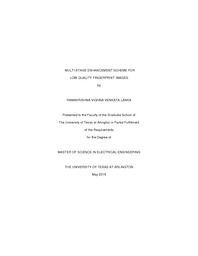
ATTENTION: The works hosted here are being migrated to a new repository that will consolidate resources, improve discoverability, and better show UTA's research impact on the global community. We will update authors as the migration progresses. Please see MavMatrix for more information.
Show simple item record
| dc.contributor.advisor | Rao, Kamisetty R. | |
| dc.creator | Lanka, Ramakrishna Vighna Venkata | |
| dc.date.accessioned | 2016-07-08T20:38:16Z | |
| dc.date.available | 2016-07-08T20:38:16Z | |
| dc.date.created | 2016-05 | |
| dc.date.issued | 2016-05-11 | |
| dc.date.submitted | May 2016 | |
| dc.identifier.uri | http://hdl.handle.net/10106/25791 | |
| dc.description.abstract | Security and authentication go hand in hand in today’s internet age. The population growth and increase in web-based services have posed a substantial risk of identity theft and fraud. The need for reliable authentication to protect one’s belongings has become essential. The goal of such an authentication system is to recognize a person by validating his/her identity.
The traditional identity management systems which validate on the basis of knowledge and tokens such as passwords and identity cards are susceptible to theft and duplication. Hence these systems cannot suffice for reliable identity management. Biometrics on the other hand validate an individual on the basis of his personal traits such as face, retina, voice and fingerprint. Since the biometric traits cannot be duplicated, the biometric system has grown to become a popular identity management system.
The fingerprint biometric has proved to be the most viable option as one’s fingerprint does not change with age, the ridge pattern on each finger is unique even between identical twins and the fingerprint matching process is relatively inexpensive compared to other forms of biometrics. Fingerprint recognition is predominantly featurebased and the features used have a physical interpretation. A feature-based method, as the name suggests, extracts explicit features from the image under consideration and encodes these features into a feature set, which is subsequently used for matching. The process of fingerprint matching comes with its drawbacks. As the fingerprint is captured as an image, it is almost certain to be corrupted by noise. The quality of the acquired fingerprint image is affected by complex input factors like shape of the sensor and ridge distortion from a moist or dry finger. The quality of the image has a significant impact on the matching performance. Hence optimal de-noising of the acquired image is crucial.
Various image enhancement schemes are investigated and a two stage combination of spatial and frequency domain enhancement scheme is studied and enhanced as part of this research. The spatial domain enhancement aims to reconstruct broken ridges by image smoothening and the frequency domain enhancement aims to eliminate noise by using a directional bandpass filter which estimates the orientation and frequency of the ridges in the fingerprint.
The scheme is implemented using MATLAB. Different fingerprint quality metrics such as performance time, true minutiae ratio (TMR) and false minutiae ratio (FMR) are measured for the proposed scheme and state of the art schemes over the standard fingerprint print databases. Conclusions are drawn based on the results. The conclusions discuss about how much the scheme was able to enhance the fingerprint image compared to the current scheme. | |
| dc.format.mimetype | application/pdf | |
| dc.language.iso | en_US | |
| dc.subject | Fingerprint | |
| dc.subject | Minutiae | |
| dc.subject | Image enhancement | |
| dc.subject | Image pyramids | |
| dc.subject | Laplacian | |
| dc.subject | Gaussian | |
| dc.title | MULTI-STAGE ENHANCEMENT SCHEME FOR LOW QUALITY FINGERPRINT IMAGES | |
| dc.type | Thesis | |
| dc.degree.department | Electrical Engineering | |
| dc.degree.name | Master of Science in Electrical Engineering | |
| dc.date.updated | 2016-07-08T20:40:24Z | |
| thesis.degree.department | Electrical Engineering | |
| thesis.degree.grantor | The University of Texas at Arlington | |
| thesis.degree.level | Masters | |
| thesis.degree.name | Master of Science in Electrical Engineering | |
| dc.type.material | text | |
| dc.creator.orcid | 0000-0003-3024-835X | |
Files in this item
- Name:
- LANKA-THESIS-2016.pdf
- Size:
- 3.793Mb
- Format:
- PDF
This item appears in the following Collection(s)
Show simple item record


